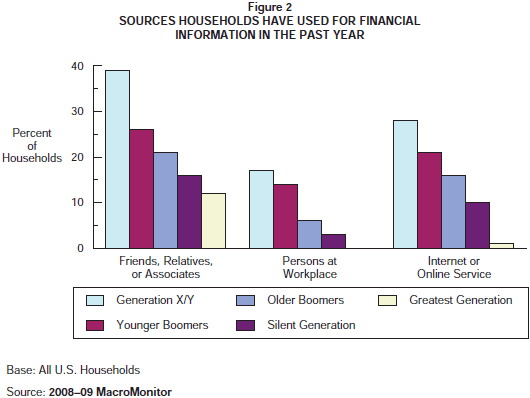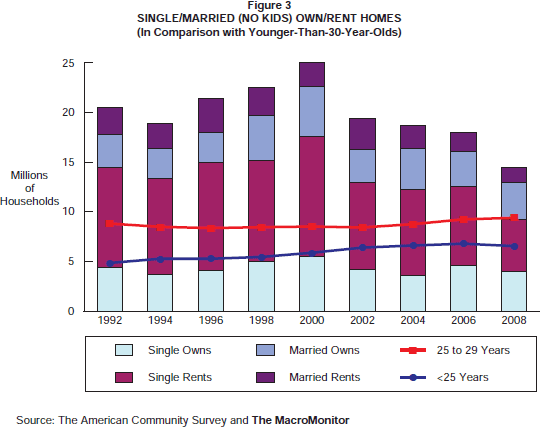MacroMonitor Market Trends February/March 2010
MacroMonitor Market Trends is a newsletter from the Consumer Financial Decisions group that highlights topical news and trends of interest to you and your colleagues. If you would like more information about the items in the newsletter or would like to discuss other ways that we can assist you in your research and marketing efforts, please contact us.
In this issue:
Consumers Still Struggling with Mortgage Debt
Historically, trended data have shown that, when they have to choose, consumers pay their monthly mortgage bills before paying their credit-card bills. A recent Trans Union report, however, found that as a result of the financial crisis and the housing-market freefall, more consumers are now opting to pay their credit-card bills rather than make their mortgage payments. In the third quarter of 2009, 6.6% of consumers were delinquent on their mortgages but current on their credit cards; 3.6% were behind on their credit-card payments but current on their mortgages. In comparison, in the third quarter of 2007, 3.95% of consumers were delinquent on their mortgages but current on their credit cards; 4.6% were behind on their credit cards but current on their mortgages.
The findings from this report highlight the difficult choices that consumers currently have to make. Deteriorating housing prices and high unemployment are forcing some households not only to reprioritize their debt obligations—in order to maximize short-term cash flow—but, in some cases, to walk way from their homes entirely. Attitudinal data from the 2008–09 MacroMonitor indicate that although the majority of households report that they would make their monthly mortgage payment even if they owed more on their house than it is worth (seven in ten households agree), a substantial consumer bloc reports that it would not: In the summer of 2008, more than 24.3 millions households (about 20% overall) disagree with the statement "Even if I owe more on my house than it's worth, I will keep making my monthly mortgage loan payments." Among households with less than 20% equity in their primary residence in 2008, more than 1.3 million reported that they would not make their monthly mortgage payment if they owed more on their home that it was worth (see Figure 1).

The data in Figure 1 in combination with fewer households paying their monthly mortgage bills do not bode recovery for the already fragile housing market and could mean another wave of foreclosures—an event that would be a serious setback to the economic recovery. We expect the next MacroMonitor survey, with fielding due to begin in April, to provide a clear picture of how these financially strained consumers are faring and to show which of these changes in consumer behavior are true, lasting shifts. The 2010–11 MacroMonitor data should help financial institutions reposition their marketing strategies and product offerings effectively to meet the needs of U.S. households in the post-mortgage-crisis era.
Social Networks for Marketing To Gen X and Gen Y
Gen X and Gen Y households represent one of the greatest emerging opportunities for financial institutions. In combination, these households represent 39% of all U.S. households, and most are entering life stages in which financial services play a more significant role. Marketers looking to capitalize on the opportunity among Gen X and Gen Y must look at alternative ways to position products and deliver meaningful marketing messages. The 2008–09 MacroMonitor shows that although Gen X/Y households are as likely as older households to obtain financial information from traditional channels like newspapers, magazines, and TV and radio advertisements, they are significantly more likely than older households to rely on online sources of information and on the advice of their friends, family or colleagues.

This seemingly insignificant data point has large implications for financial-services providers. The evolution of online social networks, online blogs, and Web-based utilities dictates that marketers ensure that their brand or product and services offerings are part of the online conversation—and that they appear in a positive light. Social networks and blogs offer an opportunity to connect with younger households in a sincere and meaningful way, which many traditional marketing channels don't offer.
Pent-Up Demand for Housing
When will the real estate market recover? When will prices stabilize? Who will buy all the existing inventory?
These and other questions are on the minds of most mortgage providers but actually have huge implications for most financial institutions, including investment firms and insurers. The MacroMonitor has demonstrated that the number of households in the formative life stages has been declining since 2000. At the same time, the number of adult household members younger than age 30 (according to the American Community Survey produced by the U.S. Census) has been increasing.

As Figure 3 shows, the number of people in the age ranges below 30 years old—typically associated with household formation (blue and red lines)—has been increasing. At the same time, the number of financially independent households in the formation life stages has been decreasing. At first glance, the reason for the latter point might seem to be that the prices for homes increased during the 2000s, making it harder for people who are just starting out to afford to buy a home. However, the number of households in the formation life stages that actually own their homes (red bars) has not changed during this time frame. It is the number that rent their homes that has declined significantly.
We know that during the same time frame, from 2000 through 2008, the number of households that have Boomerangs (adult children who are no longer dependents on their parents' taxes but who have returned to [or never left] their parents' homes) has increased to over 10 million today. Some of the decline in renting households may be these Boomerangs whose parents are no longer willing or able to subsidize their rent.
Given fewer jobs and higher debt, people in the household-formation life stages will find it even harder to rent—much less buy—homes. In the near term, we can expect that the number of households with Boomerangs will increase again and the number households in the formation stages will continue to decline—which, in combination with the fact that the number of people in age ranges below 30 will continue to increase—will create additional pent-up pressure toward new household formation. The longer that the recession drags on, the more pressure will build up. If real estate prices continue to drop (along with rental fees), at some point this pent-up demand will burst forth, unless people revert to multigenerational households. (Finally, a functional use for all those unsold McMansions!)
What should financial providers do about this prospect? As our other papers have discussed, the more a financial provider can do to help the household meet its overall needs, the more likely it is that the provider will win the household's business. In this case, creating a bundled product with an incentive that helps the Boomerang to save (maybe with matching funds from the parents), while providing help with overall budgeting and advantages when the time comes to borrow—all through the same provider—could provide a win-win-win solution. All these functions (saving, budgeting, borrowing) must be accessible online, with flexibility for adjustments and other contingencies. By combining the needs of the parents and the Boomerangs in a simple, convenient, bundled product, a financial provider can secure this household's business.